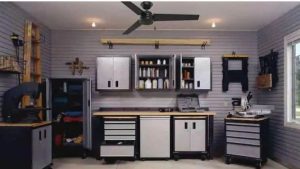I am a firm believer that ceiling fans are a useful tool for any room of the house (link to appropriate FAQ section), as well as any commercial building or property. One room that is often overlooked is the garage. Ceiling fans are actually very beneficial for a garage. Some benefits include:
- Cooling breeze when working in the garage in the summer.
- Reclaiming lost heat in the winter, not just useful for working but also for getting in and out of the car.
- Prevent dust from settling.
- Drive away bugs and other small pests.
- Reduce windshields and car windows from frosting in the winter.
- Prevent lost heat when garage doors are opened
Ceiling fans are almost always used in commercial garages. Their effectiveness in preventing heat loss, and reclaiming lost heat, is surprising to many. Installing a ceiling fan in your garage can be very low cost and you may be surprised at the results.

Have a hot garage, that you’d like to move some air around in? Garage ceiling fans are perfect for the conditions you find in the garage. Having a nice cool garage is perfect for when you want to get something done in there – and those of us who use our garages as workshops, year round.
We get a lot of emails and searches looking for “garage ceiling fans”. There are no specific ceiling fans designed for (residential) garages, however the most cost effective solution is to use industrial/commercial ceiling fans. The editors of this site recommend the Envirofan Gold Line model however there are various models of industrial/commercial ceiling fans available from $30 to $250. These are simply basic fans that are made out of metal and therefore can withstand the elements and heavy use better. Because of their basic design, you usually get a more effective fan for your money, and they are usually more energy efficient. These fans are not light adaptable and they do not have pullchains. See our industrial/commercial ceiling fan documents for more information.
If you need a light kit, a pullchain (if you are unable to operate the fan from a wall control) or if for any other reason, an industrial/commercial ceiling fan is NOT acceptable for your garage installation, you will want to pick the most simple, basic, quality ceiling fan you can. Fancy designs, remote controls, uplights, odd shaped blades, etc are all a bad idea. You want a 3 speed fan with 4 or 5 blades and a pullchain. White or brown painted will possibly last longer than brass or bronze finish, although the difference is negligible. Hugger fans will be less effective than those with a downrod, in fact for a garage, a longer downrod is usually better.
Normally a ceiling fan would be mounted in the center of the room, but with a garage, often times the garage door(s) make(s) that difficult. The most common solution is to mount the fan in the center of the room behind the garage door and opener(s), hanging low enough that the blades clear both the opener and the door itself. Depending on the design of the garage you can also mount the fan(s) on either side of the door(s) or between them. If the majority of the path of the fan blades extends below the garage doors, make sure there is at least 1′ of clearance between the door and the blades to ensure proper airflow. More is better. The bottom line is, fans should be centered as best as the layout allows, and there should be clearance on all sides of the fan blades both for safety as well as air movement.
Personally I run my garage fans on medium or low 24/7, and set them to higher when I am working in the garage. What works best for your setting may vary, but it is important to recognize that the fans do not serve their use if they are off. For best results you should keep your garage fans running unless you will be away for an extended period of time.